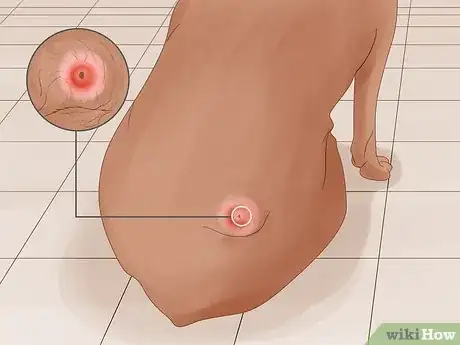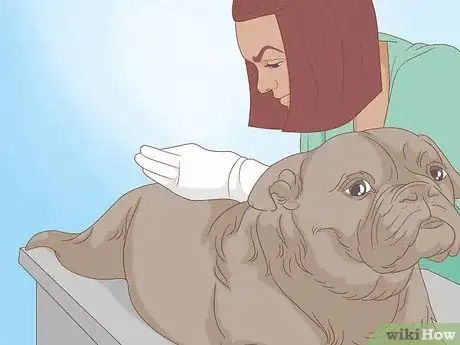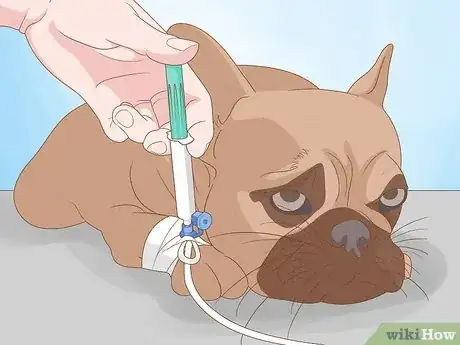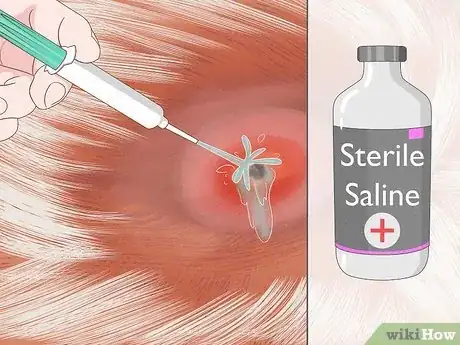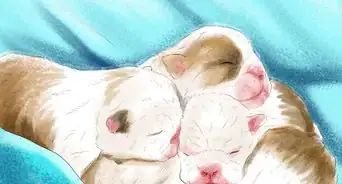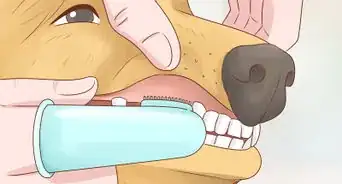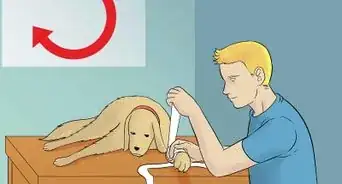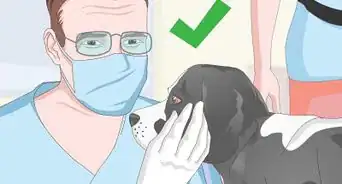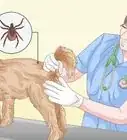This article was co-authored by Ray Spragley, DVM and by wikiHow staff writer, Dan Hickey. Dr. Ray Spragley is a Doctor of Veterinary Medicine and the Owner/Founder of Zen Dog Veterinary Care PLLC in New York. With experience in multiple institutions and private practices, Dr. Spragley’s specializations and interests include non-surgical management of cranial cruciate ligament tears, Intervertebral Disk Disease(IVDD), and pain management in osteoarthritis. Dr. Spragley holds a BS in Biology from SUNY Albany and has a Doctor of Veterinary Medicine degree (DVM) from Ross University School of Veterinary Medicine. He is also a Certified Canine Rehabilitation Therapist (CCRT) through the Canine Rehab Institute as well as a Certified Veterinary Acupuncturist (CVA) through Chi University.
There are 9 references cited in this article, which can be found at the bottom of the page.
This article has been viewed 40,054 times.
You’ve noticed your dog scratching at a bump on their skin and discovered a botfly larva—what should you do next? Although there are several home remedies for these pests floating around, the best course of action is to visit the vet. They can easily and safely remove the parasite and make your pup feel good as new. The earlier you catch the botfly, the better the outcome for your dog. That’s why we’ve put together a thorough guide to identifying and preventing botflies, including how a vet removes them from your dog’s skin. Read on to keep your canine companion safe from these parasitic pests!
Steps
Treating Botflies
-
1Take your dog to the vet right away. A veterinarian can accurately diagnose and treat a botfly infestation or wound fairly easily. They’ll take a look at the bump (and perform a CT scan if needed) to confirm it’s a botfly and rule out other parasites or infections. Botflies are officially diagnosed when the vet can see the larva inside the lump.[4]
- Botflies are usually more disgusting than they are dangerous and aren’t considered a medical emergency. However, the sooner they’re removed, the lower the chances of infections or complications are.
-
2The vet will give your dog anesthesia. A local anesthetic around the infected area is common, but the vet may sedate your dog if they’re jumpy or uncooperative. This is to make sure your pup stays relaxed and pain-free during their procedure! They will also trim or shave the fur around the wound since it will be matted with discharge (and so they can access the wound easier).[5]
- Once the wound is numbed and cleared of fur, the vet will disinfect the area for larva removal.
-
3The vet will use mosquito forceps to manually remove the larva. Mosquito forceps are like tiny scissors that let the vet grip the botfly without squeezing it too hard. They’ll be careful to remove the bug in one piece—if it rips or falls apart, the wound could get further infected or your dog could experience an allergic reaction.[6]
-
4The vet will perform surgery if the larva is too deep. It happens rarely, but botfly larvae have been known to move into a dog’s eyes, brain, spinal cord, or respiratory system if left untreated for too long. When this happens, a more invasive and lengthy procedure is needed. Your dog will be fully sedated and the vet will surgically remove the larva.[7]
- Larvae that burrow too deep are more likely to cause permanent side effects, like blindness or nerve damage. The vet will be careful to remove them without causing further harm.
- Bring your dog to the vet as soon as you notice the botfly wound for the first time to prevent the infection from escalating to this stage.
-
5When the larva is gone, the vet will sanitize the wound. They’ll flush it out with a sterile saline solution or an antiseptic to reduce the chance of post-procedure infection. If the skin around the wound is severely infected or damaged already, they may debride (surgically remove) the tissue.[8]
- Most wounds will heal naturally through granulation (letting new skin grow over the wound). Large or severe wounds may need bandages or stitches.
- Your vet will give you instructions on how to keep the wound clean while it heals. Follow their directions accurately to prevent re-infection!
-
6Your vet might prescribe medication to prevent infection. The vet will examine the wound after the larva is gone to determine whether an antibiotic or parasiticide is necessary to prevent a secondary infection (an infection that happens after treatment). It’s not always necessary—it just depends on how long the larva was in your dog’s skin and how much damage it caused.[9]
- Follow the prescription directions for the full recommended time to keep your dog healthy (and prevent another trip to the vet’s office).
-
7Monitor the wound for signs of infection while it heals. Your vet will tell you what complications to watch out for after your dog’s procedure. Look for symptoms like swelling, discharge, discoloration, or delayed healing. If you notice these symptoms, contact or visit your vet right away for further instructions or treatment.[10]
- Prognosis for your dog is excellent! Once the botfly larva is gone and the wound is disinfected, it will heal in about 2 weeks with proper care.
References
- ↑ https://veterinarypartner.vin.com/default.aspx?pid=19239&catId=102903&id=4952530
- ↑ https://www.petcoach.co/dog/condition/cuterebra/#symptoms-signs
- ↑ https://vcahospitals.com/know-your-pet/cuterebra-or-warbles-in-dogs
- ↑ https://www.merckvetmanual.com/integumentary-system/cuterebra-infestation-in-dogs-and-cats/cuterebra-infestation-in-dogs-and-cats
- ↑ https://www.mypetsdoctor.com/treatment-of-cuterebra-larva-infestation-in-cats-and-dogs
- ↑ https://www.merckvetmanual.com/integumentary-system/cuterebra-infestation-in-dogs-and-cats/cuterebra-infestation-in-dogs-and-cats
- ↑ https://todaysveterinarypractice.com/parasitology/cuterebriasis-in-dogs-and-cats/
- ↑ https://www.merckvetmanual.com/integumentary-system/cuterebra-infestation-in-dogs-and-cats/cuterebra-infestation-in-dogs-and-cats
- ↑ https://firstvet.com/us/articles/cuterebra-infestation-in-dogs-and-cats
- ↑ https://www.petcoach.co/dog/condition/cuterebra/
- ↑ https://www.petcoach.co/dog/condition/cuterebra/
- ↑ https://www.merckvetmanual.com/integumentary-system/cuterebra-infestation-in-dogs-and-cats/cuterebra-infestation-in-dogs-and-cats
- ↑ https://todaysveterinarypractice.com/parasitology/cuterebriasis-in-dogs-and-cats/
- ↑ https://www.sydney.edu.au/news-opinion/news/2019/07/24/7-tips-to-keep-your-dog-safe-from-rats-and-fatal-toxins.html
- ↑ https://www.petcoach.co/dog/condition/cuterebra/
- ↑ https://todaysveterinarypractice.com/parasitology/cuterebriasis-in-dogs-and-cats/

